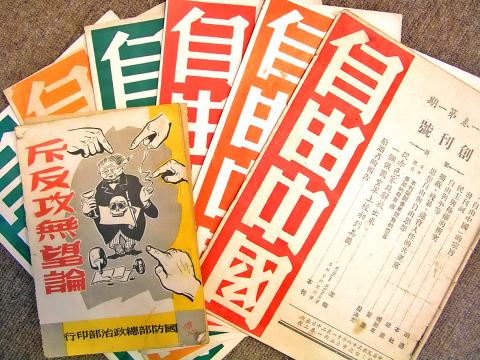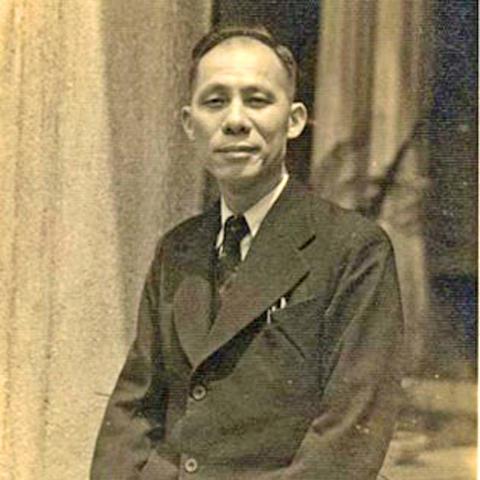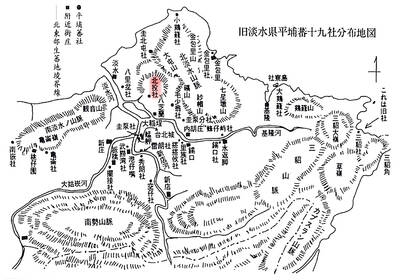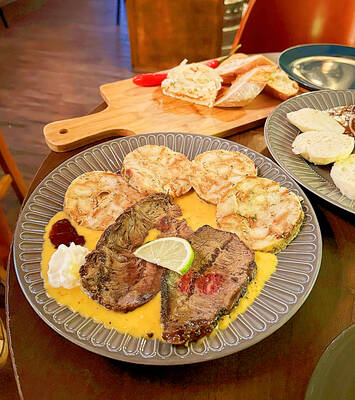Taiwan in Time: Oct. 5 to Oct. 11
In March of 1960, former president Chiang Kai-shek (蔣介石) was nearing the end of his second term, the maximum allowed under the Republic of China (ROC) constitution. In order to allow Chiang to run again, the now defunct National Assembly on March 11 amended the Temporary Provisions Effective During the Period of Communist Rebellion (動員戡亂時期臨時條款) with a provision that froze the term limit.
Back then, there were no public elections and National Assembly members were the only voters. Chiang ran unopposed that year and was subsequently elected to fourth and fifth terms before he died in 1975.

Photo: Chang Jui-chen, Taipei Times
About a month before the term limit was frozen, Free China (自由中國) magazine published on Feb. 1 an article “sincerely advising” Chiang not to run for a third term.
The magazine was founded by a group of intellectuals in 1949 in China as a pro-democracy, anti-communist publication under Chiang’s support. After the organizers retreated to Taiwan with the KMT, the magazine gradually turned from bashing communists to criticizing the lack of democracy and freedom in Martial Law era Taiwan, especially with its call for opposition parties in a time of one-party rule.
Free China’s co-founder and publisher Lei Chen (雷震) was a former high-ranking KMT official. He was expelled from the party in 1954 for running a reader-contributed editorial that criticized political interference in the education system.

Photo courtesy of Academia Historica
On March 1, Lei penned an editorial advising the National Assembly not to amend the constitution, but they did so anyway.
That May, Free China published a commentary stressing the need for a “strong opposition party.” A few weeks later, Lei and other non-KMT reformers — notable for featuring an alliance between mainlanders and ethnic Taiwanese — met to form a new party: the China Democracy Party (中國民主黨).
On Sept. 1, Free China published an article comparing the formation of opposition parties to the Yangtze River flowing east — something that cannot be stopped. That seemed to be the last straw for the KMT, as on Sept. 4, Lei and three others were arrested and charged with sedition — though the government claimed that the arrests weren’t related to opposition activities, instead accusing him of spreading communist propaganda and harboring communists. When a KMT politician spoke out against the verdict, his party membership was suspended for one year.
On Oct. 8, Chiang issued an order that Lei’s sentence should not be less than 10 years, and that no appeal should be allowed. Several hours later, Lei was sentenced to exactly 10 years in prison by a military court. Free China was shut down, and Lei’s collaborators attempted to push forward with the new party to no avail. Taiwan wouldn’t see the successful establishment of an opposition party until the 1980s.
Upon his release in 1970, Lei immediately resumed his previous mission, presenting 10 political and military reforms to the presidential office and Executive Yuan, including renaming the country the Democratic Republic of Chinese Taiwan (中華台灣民主國). He reportedly received no response. He died in 1979.
DOUBLE TEN?
Obviously, this week in history cannot be mentioned without Double Ten National Day, which, like last week’s Teachers’ Day and August’s Father’s Day, is another carryover from when the KMT ruled China and doesn’t actually pertain to Taiwan itself.
On Oct. 10, 1911, Chinese rebels started the Wuchang Uprising, which marked the beginning of the Xinhai Revolution that eventually toppled the Qing Dynasty, ending more than 2,000 years of imperial rule in China.
Even though the Republic of China was officially established on Jan. 1, 1912, later that year, the provisional government designated the anniversary of the uprising as its National Day.
Taiwan celebrated its first Double Ten in 1945 after China, then ruled by the KMT, took over following Japanese surrender. As a result of the KMT losing control of China in 1949, Double Ten became only celebrated as National Day in Taiwan.
Taiwan in Time, a column about Taiwan’s history that is published every Sunday, spotlights important or interesting events around the nation that have anniversaries this week.

Seven hundred job applications. One interview. Marco Mascaro arrived in Taiwan last year with a PhD in engineering physics and years of experience at a European research center. He thought his Gold Card would guarantee him a foothold in Taiwan’s job market. “It’s marketed as if Taiwan really needs you,” the 33-year-old Italian says. “The reality is that companies here don’t really need us.” The Employment Gold Card was designed to fix Taiwan’s labor shortage by offering foreign professionals a combined resident visa and open work permit valid for three years. But for many, like Mascaro, the welcome mat ends at the door. A

The Western media once again enthusiastically forwarded Beijing’s talking points on Japanese Prime Minister Sanae Takaichi’s comment two weeks ago that an attack by the People’s Republic of China (PRC) on Taiwan was an existential threat to Japan and would trigger Japanese military intervention in defense of Taiwan. The predictable reach for clickbait meant that a string of teachable moments was lost, “like tears in the rain.” Again. The Economist led the way, assigning the blame to the victim. “Takaichi Sanae was bound to rile China sooner rather than later,” the magazine asserted. It then explained: “Japan’s new prime minister is

NOV. 24 to NOV. 30 It wasn’t famine, disaster or war that drove the people of Soansai to flee their homeland, but a blanket-stealing demon. At least that’s how Poan Yu-pie (潘有秘), a resident of the Indigenous settlement of Kipatauw in what is today Taipei’s Beitou District (北投), told it to Japanese anthropologist Kanori Ino in 1897. Unable to sleep out of fear, the villagers built a raft large enough to fit everyone and set sail. They drifted for days before arriving at what is now Shenao Port (深奧) on Taiwan’s north coast,

Divadlo feels like your warm neighborhood slice of home — even if you’ve only ever spent a few days in Prague, like myself. A projector is screening retro animations by Czech director Karel Zeman, the shelves are lined with books and vinyl, and the owner will sit with you to share stories over a glass of pear brandy. The food is also fantastic, not just a new cultural experience but filled with nostalgia, recipes from home and laden with soul-warming carbs, perfect as the weather turns chilly. A Prague native, Kaio Picha has been in Taipei for 13 years and